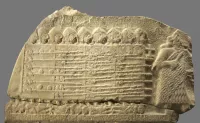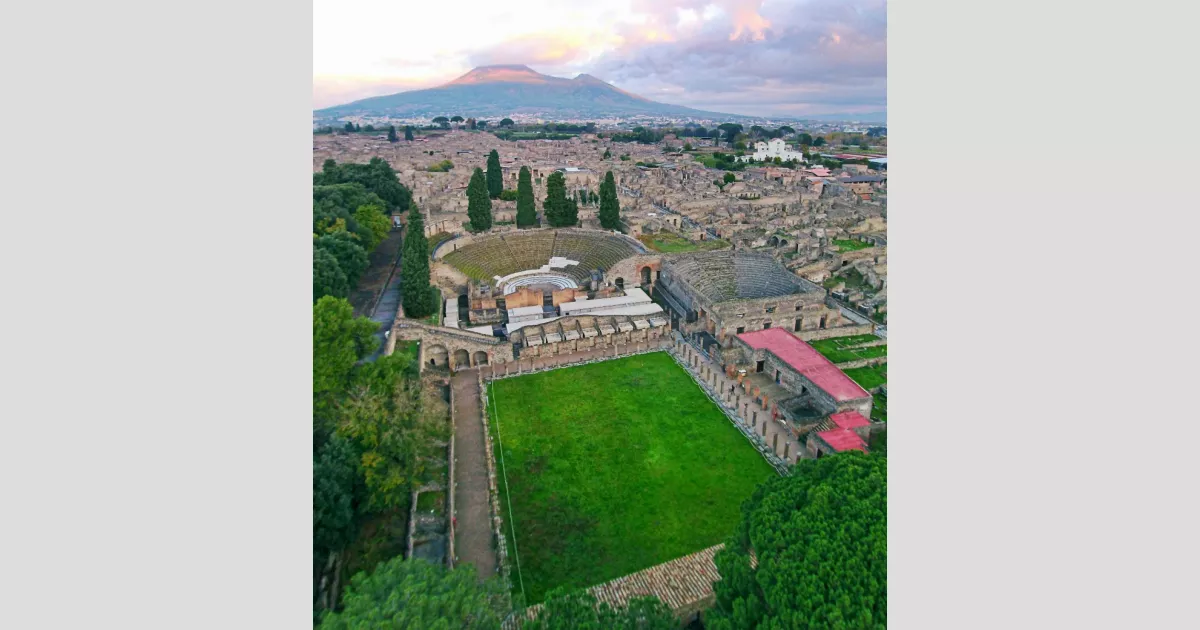"Pompeii, an ancient city near Naples, Italy, was tragically buried by the eruption of Mount Vesuvius in 79 AD. The city, along with nearby Herculaneum and Stabiae, was covered in meters of ash and pumice, preserving it for centuries. Today, Pompeii stands as a haunting reminder of the power of nature and a window into Roman life."
1943: World War II Bombing Damage
During World War II, the Antiquarium of Pompeii suffered significant damage in 1943 as a result of bombings.
1954: Journey to Italy Film Release
The film "Journey to Italy," starring George Sanders and Ingrid Bergman, was released in 1954. The movie includes a scene set in Pompeii where the characters witness the excavation of a cast of a couple who perished during the eruption of Mount Vesuvius.
1960: Excavation of Pompeii
By 1960, most of Pompeii had been uncovered. However, the excavated areas were left in a state of decay, leading to a halt in major excavations.
1971: Pink Floyd: Live at Pompeii
In 1971, the rock band Pink Floyd filmed a live concert, titled "Pink Floyd: Live at Pompeii," in the ancient Roman amphitheater. The performance, featuring six songs, had a limited audience consisting of the film crew and local children.
1980: Discovery of Etruscan Presence
Excavations in 1980 and 1981 revealed evidence of Etruscan presence in Pompeii, including inscriptions and a 6th-century BC necropolis.
1980: Earthquake Damage
In 1980, an earthquake caused further damage to the Antiquarium of Pompeii, leading to its closure.
1980: Earthquake Damage and Preservation Efforts
The severe earthquake of 1980 caused significant damage to Pompeii, leading to questionable reconstruction efforts. This event highlighted the need for improved preservation practices and documentation of the ruins.
1981: Discovery of Etruscan Presence
Excavations in 1980 and 1981 revealed evidence of Etruscan presence in Pompeii, including inscriptions and a 6th-century BC necropolis.
1985: Siouxsie and the Banshees Release "Cities in Dust"
The post-punk band Siouxsie and the Banshees released their song "Cities in Dust" in 1985. The song, which describes the destruction of Pompeii and Herculaneum, was featured on their album "Tinderbox." Notably, the single's cover art featured an image of the plaster cast of a dog that perished in Pompeii.
1996: World Monuments Watch Listing
The World Monuments Fund included Pompeii in its 1996 World Monuments Watch, highlighting the urgent need for restoration and a comprehensive plan for the site's preservation.
1997: UNESCO World Heritage Site Designation
Pompeii was officially recognized as a World Heritage Site by UNESCO in 1997, acknowledging its outstanding universal value and significance to human history.
1998: Rediscovery of Priapus Fresco
A previously concealed reproduction of a wall fresco depicting Priapus, the ancient god of sex and fertility, was rediscovered in 1998 due to rainfall. The fresco, originally hidden "out of prudishness" because of its depiction of Priapus with an enlarged penis, was once again made accessible.
1998: World Monuments Watch Listing
The World Monuments Fund included Pompeii in its 1998 World Monuments Watch, highlighting the urgent need for restoration and a comprehensive plan for the site's preservation.
2000: Reopening of the Naples "Secret Museum"
The Naples "Secret Museum," housing erotic artwork from Pompeii and Herculaneum, was reopened to the public in 2000. Originally closed off in the 19th century due to the sensitive nature of the exhibits, the museum's reopening marked a significant shift in cultural attitudes towards the display of ancient Roman sexuality.
2000: World Monuments Watch Listing
The World Monuments Fund included Pompeii in its 2000 World Monuments Watch, highlighting the urgent need for restoration and a comprehensive plan for the site's preservation.
2003: Publication of "Pompeii" by Robert Harris
Robert Harris published his novel "Pompeii" in 2003. The book tells a fictional story set against the backdrop of the days leading up to the eruption of Mount Vesuvius, centering around an aquarius's efforts to repair a damaged aqueduct.
2008: Pompeii's Popularity and Tourism Management
By 2008, Pompeii had become one of Italy's most popular tourist destinations, attracting close to 2.6 million visitors annually. To address the challenges posed by high tourist volume, the 'Soprintendenza Archeologica di Pompei' introduced new ticketing options that included access to nearby sites like Herculaneum, Stabiae, and the Villa Poppaea. This initiative aimed to alleviate pressure on Pompeii and encourage visitors to explore other significant historical locations.
2010: Study on the Cause of Death
In 2010, a study revealed that the primary cause of death for people in Pompeii during the eruption was not ash suffocation, as previously believed, but extreme heat from pyroclastic flows.
2010: Schola Armatorum Collapse
In 2010, the Schola Armatorum, also known as the "House of the Gladiators," collapsed due to heavy rainfall and inadequate drainage. While not accessible to the public, the exterior of the structure was a visible attraction for tourists. This incident sparked significant controversy and accusations of neglect.
2012: Conservation Funding and Study
In 2012, a study highlighted the need for improved interpretation and presentation strategies at Pompeii as a cost-effective approach to enhancing conservation efforts in the short term. This recognition stemmed from the realization that existing funding, primarily allocated for site conservation, was insufficient to address the extensive decay across the vast site.
2012: Grande Progetto Pompei
The "Grande Progetto Pompei," a five-year project, commenced in 2012 with support from the European Union. Its primary focus was the stabilization and conservation of buildings situated in the most vulnerable areas of Pompeii.
June 2013: UNESCO Warning
UNESCO issued a warning in June 2013, stating that Pompeii could be placed on the List of World Heritage in Danger if substantial progress in restoration and preservation was not demonstrated within two years.
2013: Release of Bastille's "Pompeii"
The British band Bastille released their song "Pompeii" in 2013. The song's lyrics make reference to the ancient city and the devastating eruption of Mount Vesuvius.
2014: Release of the Film "Pompeii"
A historical disaster film titled "Pompeii," directed by Paul W. S. Anderson, was released in 2014. The film, a German-Canadian production, depicts the events surrounding the eruption of Mount Vesuvius and its impact on the city of Pompeii.
2014: New Management Plan
In 2014, UNESCO headquarters received a revised management plan for Pompeii. The plan aimed to improve the integration of management, conservation, and maintenance programs for the site.
2016: David Gilmour's Concert at Pompeii
45 years after Pink Floyd's iconic performance, guitarist David Gilmour returned to the Pompeii amphitheater in 2016 for a live concert as part of his "Rattle That Lock" tour. This event was historically significant as it marked the first time an audience had been present for a concert in the amphitheater since the eruption of Mount Vesuvius in 79 AD.
2016: Temporary Exhibition Space
Prior to its full reopening in 2021, the Antiquarium of Pompeii served as a venue for temporary exhibitions starting in 2016.
December 2018: Discovery of Horse Remains
In December 2018, archaeologists uncovered the remains of harnessed horses in the Villa of the Mysteries.
2018: Charcoal Inscription and Eruption Date
A charcoal inscription found in 2018, bearing the date of October 17, provided new evidence suggesting a later date for the eruption of Mount Vesuvius.
2018: Discovery of Stable
A stable was discovered in 2018 at the luxurious villa in Civita Giuliana, north of Pompeii.
2018: Discovery of "Leda and the Swan" Fresco
An ancient fresco portraying an erotic scene of "Leda and the Swan" was unearthed in Pompeii in 2018.
November 2020: Discovery of Two Men in Ash Layer
In November 2020, the remains of two men, believed to be a wealthy man and his slave, were discovered in a thick layer of ash. It's thought they survived the initial eruption but perished in a subsequent blast.
December 2020: Discovery of Thermopolium
Archaeologists excavated a thermopolium, an ancient Roman snack bar, in December 2020. The find included well-preserved frescoes, food remnants in terracotta pots, and the skeleton of a small dog, indicating selective breeding practices.
2020: Recreation of Gardens and Vineyards
The year 2020 saw the meticulous recreation of numerous domus gardens, orchards, and vineyards in Pompeii. These reconstructions, based on depictions found in frescoes and archaeological findings, aimed to provide visitors with a more accurate understanding of their appearance before the eruption of Mount Vesuvius.
January 2021: Discovery of Ceremonial Chariot
A well-preserved four-wheeled ceremonial chariot was uncovered in January 2021, in the portico of a luxurious villa. The chariot, believed to be a pilentum, a type of bridal carriage, has been restored for display.
January 2021: Reopening of the Antiquarium of Pompeii
After being closed for 36 years, the Antiquarium of Pompeii reopened to the public in January 2021 as a permanent exhibition space. The museum showcases archaeological discoveries from Pompeii, including casts of victims of the Mount Vesuvius eruption and displays illustrating the city's history.
2021: Discovery of Freed Slave's Tomb
In 2021, archaeologists discovered the tomb of Marcus Venerius Secundio, a freed slave. The tomb contained mummified remains and inscriptions detailing his achievements and the organization of cultural events, providing insights into the life of freedmen in Roman society.
2021: Reopening of Domus and New Excavation
In 2021, several domus, previously closed for restoration, were reopened to the public. These included the House of the Ship Europa, House of the Orchard, and House of the Lovers. Additionally, the newly excavated House of Leda and the Swan was also opened to visitors.
2022: Collaborative Study on Eruption Date
In 2022, a collaborative study determined that the eruption of Mount Vesuvius most likely occurred on October 24-25.
2023: Discovery of Earthquake Damage
Archaeological findings in 2023 showed that some buildings in Pompeii collapsed due to earthquakes during the eruption, leading to the deaths of those inside.
2023: Restoration of Chariot
The elaborate and unique bridal carriage called a pilentum has been restored in 2023 for display at the Baths of Diocletian.
April 2024: Discovery of Dining Hall with Frescoes
In April 2024, a dining hall adorned with rare frescoes, including depictions of Helen of Troy and Paris, and Apollo and Princess Cassandra, was excavated as part of a project to stabilize the perimeter of the site. The hall's walls were painted black, possibly to conceal soot marks.
Mentioned in this timeline

An earthquake is the shaking of the Earth's surface caused...

Books are a means of storing information as text or...
Italy officially the Italian Republic is located in Southern and...

The horse scientifically known as Equus ferus caballus is a...

War is defined as an armed conflict involving the organized...

Pink is a pale tint of red named after the...
Trending

Simon Cowell is a prominent English television personality and businessman recognized for his role as a judge on various talent...

7 months ago Gary Payton Reflects on Jordan Matchup and Hypothetical Stats in Today's NBA

11 days ago Spurs Defeat Nuggets in Thrilling Game, Mavericks Face Nuggets

22 days ago Michael Douglas and Catherine Zeta-Jones Celebrate 25 Years of Marriage with Throwbacks
Luke Kornet is an American professional basketball player currently playing for the San Antonio Spurs in the NBA He's a...

6 months ago Jack Black's Minecraft Movie Sets Premiere on HBO Max, June 20, 2025
Popular

Candace Owens is an American conservative political commentator and author...

Ilhan Omar is an American politician currently serving as the...

XXXTentacion born Jahseh Dwayne Ricardo Onfroy was a controversial yet...

Tom Cotton is an American politician and Army veteran currently...
The Kennedy Center Honors are annual awards recognizing individuals and...

Kelsey Grammer is an accomplished American actor producer and singer...
